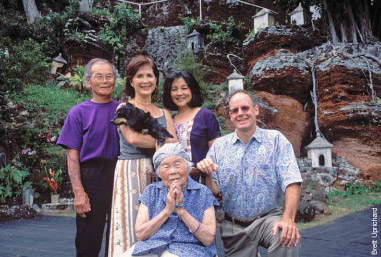 Leading the effort to build the Lawai International Center are (seated) Takano Nonaka; (behind her, left to right) her son Iwao Nonaka; Gloria Nakea, a director of the center; Lynn Muramoto, president; and Mark Hubbard, vice president and a director of the center.
Leading the effort to build the Lawai International Center are (seated) Takano Nonaka; (behind her, left to right) her son Iwao Nonaka; Gloria Nakea, a director of the center; Lynn Muramoto, president; and Mark Hubbard, vice president and a director of the center.
Takano Nonaka came to Kaua'i with one suitcase and a
heart full of hope. She arrived in 1921 from Japan, settled
with her husband in Hanapepe and raised 10 children,
seven of them boys. When World War II and the Korean
War called four of her sons into service, she went to her
place of comfort, a Shingon Buddhist temple tucked away
in a valley named Lawai. From each one of the 88 shrines
that snake up the steep, hillside, she took a pinch of the
earth and placed it into four Bull Durham tobacco pouches.
She pinned a pouch on each of her departing sons and
promised that when they returned, they would take the soil
back to its source.
One by one, her sons returned. Pouch by pouch, they
returned the soil to Lawai.
Grandma is 97 years old now, stooped with age, radiant
with peace. She has visited the site regularly for 60 years.
Through decades of neglect, when the shrines were
abandoned, overgrown, she never stopped visiting. "Cannot
see, but get power over there," she says hands clasped.
Iwao, her 75-year-old son, takes her there without fail. Last
August, the Nonakas were among a diverse group that
gathered there to celebrate a new beginning: the nonprofit
Lawai International Center (www.lawaicenter.org,
(808)822-5942), a humanitarian effort that will become an
international, multicultural, and nondenominational center
for those seeking peace and healing.
"This has always been a natural place of healing," explains
Lynn Muramoto, president of the organization. "In the earliest
days in this valley, there was a heiau [temple]where the
Hawaiians brought their wounded and sick to heal." As the
immigrant groups arrived for the plantations, they too came
for nurturance. They built Taoist and Shinto temples, and in
1904, the 88 shrines on the hillside with their figures of stone
and wood.
But when the minister died, the temple languished and
activities ceased for all but a few stalwarts. The 32-acre
complex, the only one of it's kind outside of Japan, is an
archaeological and cultural treasure, a miniature replication
of 88 shrines of Shikoku, Japan, built along a 1,000 mile
long trail established more than 1,000 years ago. Despite
these origins Muramoto stresses that this will not be a
religious or a Buddhist center, but a globally inclusive
destination where people of diverse interests, ethnicities
and cultures can gather.
A broad spectrum of volunteers from the mainland and Hawai'i
has appeared out of nowhere. Supporters sell beef stew,
malasadas, mango seed and orchids to raise money year-
round. "Angels have stepped forward with large donations to
"honor a shrine" in the name of their loved ones and help pay
the $250,000 mortgage, miraculously reduced from its original
$6 million asking price. Kaua'i Boy Scouts Troop 83 comes
twice a month to clear and clean. Plans call for a gathering
pavilion and learning center for education and the arts, guest
cottages, sweeping paths for reflective walks, and, all around,
the beauty of a valley that has long been a refuge.
Sharon Masuoka tells a story of their great-grandfather who,
in 1917, walked 28 miles from Kapa'a to Lawai to pray at the
shrines for this daughter's arrival. Unable to afford shoes,
he walked barefoot. That same day in Japan, after repeatedly
failing a physical exam because of her glass eye, his daughter
poised to leap into the ocean in desperation, finally received
her passport. Like Takano Nonaka after her, she came to
Kaua'i and set down roots for the generations to follow,
"Get power over there," says Nonaka.




